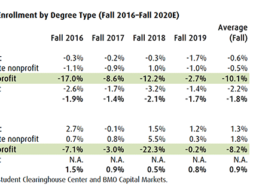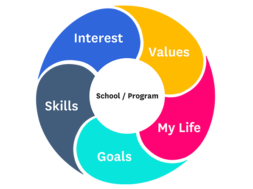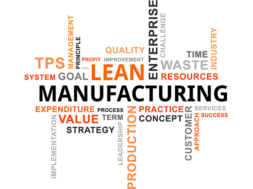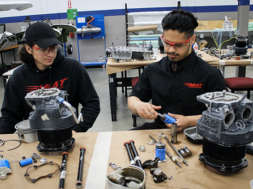
Motivating Admissions Professionals Working in Higher Education
By Dr. Candace L. Goodwin, Metro President, DeVry University
The prolonged economic recession in the United States has required most organizations to operate more efficiently, building an infrastructure of doing more with less (Brandl & Traxler, 2011). The economic state has especially affected private sector institutions of higher education, especially combined with simultaneous changes in the Department of Education regulations governing this sector (Cellini & Goldin, 2012; Simmons, 2013). The result is a decline in new student enrollments in many institutions requiring college and universities to reevaluate resource allocation and staffing models to align specifically with enrollment levels (Cellini & Goldin, 2012; Lederman, 2012).
According to the United States Department of Education’s National Center for Education Statistics, for the first time in 15 years there was a decrease in enrollments in institutions of higher education between fall of 2010 and fall of 2011 (Lederman, 2012). The research also indicates that private sector institutions of higher education enrollments declined even more significantly than public and independent institutions. During this timeframe there were many external economic and environmental factors influencing the decrease in enrollment, including the elimination of the Safe Harbor ruling made in 2010 during the Higher Education Act’s Reauthorization (Lederman, 2012)
Combining the staffing level changes, the regulatory changes, and the concept of doing more with less, makes it imperative to influence the working environment of admissions professionals in higher education in a positive direction.
How to motivate employees has been a recent topic of discussion among administrators within many corporations (Pink, 2009). Organizations have wanted satisfied employees because this results in increased productivity and the long-term profitability of the organization. Employee motivation is also a key priority in higher education; yet, considered as complex and dependent on many factors (Kukanja, 2013; Herzberg, 2003).
Likewise, there have been many issues facing higher education. One issue emerged in 2010 when the Title IV regulation changed regarding employee compensation in relationship to student enrollment (Simmons, 2013). In 2002, the Higher Education Act (HEA) introduced 12 Safe Harbor guidelines allowing individuals working in institutions of higher education the opportunity to receive compensation (in some way) based on enrollments (Simmons, 2013; Blumenstyk, 2011). The 2010 Title IV changes made to the Safe Harbor guidelines eliminated the standards previously developed in 2002, resulting in institutions of higher education no longer having the opportunity to reward colleagues any incentives based on the number of students enrolling or graduating (Simmons, 2013; Burd, 2010). These regulatory changes required colleges and universities to review and possibly alter the pay structure for individuals working in a Title IV function (admissions or student financial aid). As graduation rates become an increasingly important component to evaluate colleges and universities, the HEA recently modified the ruling regarding compensation of recruiters by the Obama administration reinstating compensation based on student graduation as an appropriate means to compensate advisors (Stratford, 2015).
The question that continues to arise is what to do in terms of motivating admissions professionals in light of all the changes to the higher education landscape.
For purposes of this study, the researcher surveyed admissions professionals working for one particular private-sector parent company with multiple locations across the country. The accessible population to the researcher was a convenience sample of approximately 1,000 admissions professionals working throughout the United States at a particular private sector university. The researcher identified all admissions professionals employed at two institutions within one private sector organization as the research participants.
This study sought to identify intrinsic and extrinsic factors that motivated admissions professionals employed at two private sector institutions of higher education. A second purpose of the research was to identify any significance in demographic characteristics of the participants as they related to motivation. The researcher made modifications to Paul Spector’s Job Satisfaction Survey© (1985) to ask questions more specific to changes in Title IV regulations made in 2010.
Motivational Model
Safe work environment
The motivational model begins with creating a safe and secure work environment. Due to the unpredictable nature of the current climate in higher education, individuals responded to the survey and mentioned safety and security several times. According to Maslow, the first priority of creating a motivating environment is to understand the importance of the security and safety needs of the admissions professional (Gorman, 2010; Parde, 1990). If a safety need is not satisfied this overshadows everything else and ultimately reinforces the employees’ inability to move past their basic needs to focus on their psychological needs or the needs of the organization (Parde, 1990).
Clarity of goals, vision and expectations
The next important component of the model is to ensure that there is clarity of goals, vision, and expectations. Organizational culture is an important determinant in the motivation level among employees (Mahal, 2009; Dartey-Baah, 2010). The expectation of an organizational leader is to influence their followers to believe in the mission and vision of the organization. This required leaders to understand, embrace, cultivate, and communicate the mission and vision accordingly to all levels within the organization (Isaac, Zerbe, & Pitt, 2001). Continuous communication and clarification of the vision, goals, and objectives of the organization also significantly enhances employee motivation (Hardre’ & Reeve, 2009).
The primary goal is to articulate the vision, goals, and strategic direction of the University and cultivate it by developing a shared culture in which all employees are equal participants, working together for a common purpose.
Using a variety of communication channels is also necessary to develop a multi-layer dialogue with clear and consistent messages to share results with colleagues.
Clarity of compensation, rewards, and recognition
The survey responses indicated that colleagues required full explanation of compensation, rewards and recognition to understand performance expectations. Although the current regulatory environment in private sector higher education has restricted compensation based on enrollments, it still has been imperative for admissions professionals to understand how their performance is measured. Additionally, there is opportunity to change compensation with the recent reinstatement of compensation based upon graduation rates. According to the survey, the development and communication of a concrete reward and recognition program is essential to motivate individuals working in admissions.
Managing performance outcomes
According to Vroom’s Expectancy Theory (Locke & Latham, 2004) individual performance increases when there is a linkage between effort and success in achieving performance outcomes. Employee motivation also increases when there is clear communication of performance expectations and assessment criteria of performance outcomes (Ciorgabiu-Naon, 2010). Although, monetary form of rewards and recognition are restricted, there are many creative ways to reward and recognize colleagues without the use of money. According to Larkin, Pierce and Gino (2012) when individual performance was observably differentiated based on skills and contribution; performance based goals were important. Therefore, clearly defining a formal rewards and recognition program based on performance (even at the group level) should increase performance and colleague motivation (Larkin, Pierce & Gino, 2012).
Empowerment of colleagues to make decisions
According to Manzoor (2012), the two central factors leading to employee motivation are empowerment and recognition. Empowerment of employees provide the opportunity for creativity and the ability to influence organizational decisions and outcomes (Manzoor, 2012; Pink, 2009). Additionally, increased profitability and organizational growth will result when an organization recognizes that the design of policies and procedures should empower employees to make decisions.
McGregor’s Theory Y provides a good model to explore how to motivate admissions professionals to achieve both personal and organizational goals. 1) Provide the goals and objectives; 2) Provide appropriate rewards and recognitions to reinforce behaviors resulting in achieving outcomes; 3) and allow employee participation in decision-making (Kopelman, et al., 2008). According to Kopelman et al (2008), creating a Theory Y environment can positively correlate to job satisfaction (motivation) but not necessarily job performance.
Increasing & enhancing training and development opportunities
According to Daniel Pink (2009), autonomy, mastery, and purpose are the intrinsic motivators that increase both performance, motivation, and engagement.
The need for mastery is rooted in the desire to do something better than before. Individuals who have a high need for achievement are motivated by the levels they accomplish and also demotivated or experience despondency with lower levels of achievement. Individuals with a high need for achievement typically work harder at achieving higher levels of responsibility, desire mastery in their field, and yearn for frequent feedback on their performance (Royle & Hall, 2012; McClelland & Koestner, 1992). Additionally, there is a need for affiliation with their work group of professionals. Affiliation may also provide safety and security in unsettling situations (Royle & Hall, 2012; McClelland & Koestner, 1992). Therefore, a robust training and development plan along with group affiliation should increase colleague motivation.
Listen to the opinion of employees
Communication interaction is crucial to employee motivation and job satisfaction. Listening to the opinion of an employee gains employee feedback and insight on opportunities for improvement within an organization. Implementing changes based on employee feedback will create and foster an environment of trust and motivation (Manzoor, 2012). Employees expect to feel valued and motivation increases when employees feel like their opinion counts (Herzberg, 2003). To value the opinion of employees, an effective organization increases effective communication regarding goals, vision, job descriptions and expectations of each role. The development and definition of job descriptions and role clarity is essential to establishing a culture of accountability.
The participants in the survey also indicate the need to have more control over their role. Karasek’ s demand-control model supports the fact that without job control, high demand jobs lead to higher levels of stress (Karasek, 1979). According to VanYperen & Hagedoorn (2003), the consequences of high demand jobs are increased fatigue and exhaustion. However, VanYperen & Hagedoorn’s research resulted in the understanding that listening to the opinions of employees increased intrinsic motivation, resulting in the increased feelings of both job control and job social support. Employees’ perceived level of support from their supervisor and colleagues increases the level of intrinsic motivation. Job satisfaction typically increases through increased job control, such as discretion over schedule and day-to-day operational decisions. Instead of reducing the demands of the job, by enhancing job control and job support, the productivity and intrinsic motivation of the employees increases (VanYperen & Hagedoorn, 2003).
Creating a culture of cohesiveness and trust
Motivation of employees begins at the stage of hiring.
Understanding the intrinsic and extrinsic preferences of each new hire should enhance employee engagement and increase productivity.
Hiring individuals that fit the organizational culture and that care about the organizational goals and mission should be essential to the success of both the individual and the organization. Additionally, the environment should provide opportunities for employees to take individual initiatives and learn new skills, ultimately increasing employee motivation and gaining stronger employee commitment (Gallie et al., 2012; Stone, et al., 2009).
Performance management is also important and should be developed and explained to effectively assess and measure workforce competency. These changes are necessary to help create and foster an environment of trust and motivation among the employees. A motivated staff can bring a lot to an organization and individuals that are motivated tend to stay employed in their current role. However, if colleagues are dissatisfied, they tend to leave an organization, increasing the cost and decreasing the productivity of any organization.
In conclusion, motivation for admissions professionals is complicated. The lack of statistical significance when applying the analyses of variance for the research question did not negate the importance of understanding the variation within each of the independent items that were part of this study. The complexity of an individual’s motivation should not be under-estimated when trying to determine what factors are operating within, and across, the role of the admissions professional. Based on the results of the survey participants, the implementation of the motivational model developed through this research would significantly increase motivation. However, each individual manager should carefully consider the needs of each individual to determine how best to motivate that person while still staying within the provisions of the Safe Harbor guidelines.
Figure 1: Goodwin Motivational Model ©2014
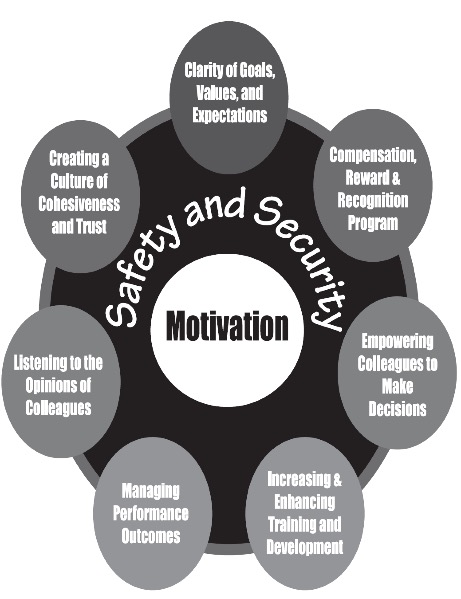

Dr. Candace Goodwin , has over 25 years of higher education experience working for both for-profit and non-profit universities. Her experience includes leadership roles in academics, enrollment management, and operations. In these roles, Dr. Goodwin has gained exceptional experience in leading innovation and change and strategic planning and implementation. In her current role, as Metro President of DeVry University, strategic planning has resulted in increased revenue through new student enrollment and persistence initiatives resulting in both student and colleague satisfaction. Dr. Goodwin is results driven and one of her leadership competencies includes the ability to drive excellence in execution. Additionally, she has a strong focus on human resources and organizational development resulting in her commitment to faculty development with a specific focus on diversity of both faculty and staff. Her educational background includes a Doctorate of Education in Organizational Leadership, a Masters of Business Administration in Human Resources Management and a Bachelors of Art in Finance. Dr. Goodwin has been married for 35 years and has 2 children and 2 grandchildren.
Contact Information: Dr. Candace Goodwin // Metro President // DeVry University
References
Adams, S. (2012). Pressure Rising on For-Profit Colleges. Forbes.Com, 55.
Blumenstyk, G. (2011). Fast-growing U. of Phoenix calculates a more careful course. Chronicle of Higher Education, 57(23).
Blumenstyk, G. (2011). With lawsuit, for-profit colleges step up fight against new regulations. Chronicle of Higher Education, 57(22), A13.
Brandl, B., & Traxler, F. (2011). Labour relations, economic governance and the crisis: turning the tide again? Labor History, 52(1), 1-22.
Burd, S. (2010, November 11). Obama’s has bid to change the incentives that drive for-profit higher Ed. Higher Ed Watch. The New America Foundation. Retrieved from http://higheredwatch.newamerica.net/blogposts/2010/obama_s_bid_to_
change_the_incentives_that_drive_for_profit_higher_education-34941
Cellini, S. (2012). For-profit higher education: An assessment of costs and benefits. National Tax Journal, 65(1), 153-179.
Cellini, S. & Goldin, C. (2012). Does federal student aid raise tuition? New evidence on for-profit colleges. NBER working paper number 17827. Cambridge, MA:
National Bureau of Economic Research.
Ciorgabiu-Naon, R. (2010). Modalities of non-financial motivation of employees within organizations. Annals of the University of Petrosani Economics, 10(4), 41-54.
Dartey-Baah, K. (2010). Job satisfaction and motivation: Understanding its impact on employee commitment and organizational performance. Academic Leadership (15337812), 8(4), 11-21.
Gallie, D., Zhou, Y., Felstead, A., & Green, F. (2012). Teamwork, skill development and employee welfare. British Journal of Industrial Relations, 50(1), 23-46.
Gorman, D. (2010). Maslow’s hierarchy and social and emotional wellbeing. Aboriginal & Islander Health Worker Journal, 34(1), 27-29.
Hardre’, P. L., & Reeve, J. (2009). Training corporate managers to adopt a more autonomy-supportive motivating style toward employees: An intervention study.
International Journal of Training and Development, 13(3), 165-184.
Herzberg, F. (2003). One more time: How do you motivate employees? Harvard business review, 81(1), 86–96.
Isaac, R. G., Zerbe, W. J., & Pitt, D. C. (2001). Leadership and motivation: The effective application of expectancy theory. Journal of Managerial Issues, 13(2), 212.
Karasek, R. A. (1979). Job demands, job decision latitude, and mental strain: Implications for job redesign. Administrative Science Quarterly, 24, 285-311.
Kinser, K. (2009). Access in U.S. higher education: What does the for-profit sector contribute? Program for Research on Private Higher Education. Retrieved from: http://www/albany.edu/dept/eaps/prophe/publication/paper.html.
Kopelman, R. E., Prottas, D. J., & Davis, A. L. (2008). Douglas McGregor’s Theory X and Y: Toward a construct-valid measure. Journal of Managerial Issues, 20(2), 255-271.
Kukanja, M. (2013). Influence of demographic characteristics on employee motivation in catering companies. Tourism & Hospitality Management, 19(1), 97-107.
Larkin, I., Pierce, L., & Gino, F. (2012). The psychological costs of pay-for-performance: Implications for the strategic compensation of employers. Strategic
Management Journal, 33, 1194-1214.
Lederman, D. (2012). Higher Ed shrinks. Retrieved from http://www.insidehighered.com
Locke, E. A., & Latham, G. P. (2004). What should we do about motivation theory? Six recommendations for the twenty-first century. Academy of management review, 29(3), 388–403.
Mahal, P. (2009). Organizational culture and organizational climate as a determinant of motivation. IUP Journal of Management Research, 8(10), 38-51.
Manzoor, Q. (2012). Impact of employees motivation on organizational effectiveness. Business Management & Strategy (BMS), 3(1), 1-12.
McClelland, D. C., & Koestner, R. (1992). The achievement motive. In Royle, M., & Hall, A. T. (2012). The relationship between McClelland’s theory of needs, feeling individually accountable, and informal accountability for others. International Journal of Management & Marketing Research, 5(1), 21-42.
Pardee, R. L. (1990). Motivation theories of Maslow, Herzberg, McGregor & McClelland. A literature review of selected theories dealing with job satisfaction and motivation. Available from: ERIC, Ipswich, MA. Accessed March 23, 2014.
Pink, D. (2009). Drive: The surprising truth about what motivates us. New York: Penguin Group.
Royle, M., & Hall, A. T. (2012). The relationship between McClelland’s theory of needs, feeling individually accountable, and informal accountability for others.
International Journal of Management & Marketing Research (IJMMR), 5(1), 21-42.
Simmons, O.S. (2013). For profits and the market paradox. Wake Forest Law Review, 48(2), 333-360.
Spector, P. (1985). Measurement of human service staff satisfaction: development of the job satisfaction survey. American Journal of Community Psychology, 13(6), 693-713.
Stone, D.N., Deci, E.L., & Ryan, R.M. (2009). Beyond talk: Creating autonomous motivation through self-determination theory. Journal of General Management, 34(3), 75-91.
Stratford, M. (2015). Reversal on recruiter bonus pay. Inside Higher Ed. Retrieved from https://www.insidehighered.com/news/2015/11/30/us-loosens-part-its-ban-college-recruiter-pay
VanYperen, N.W. & Hagedoorn, M. (2003). Do high job demands increase intrinsic motivation, fatigue, or both? The role of job control and job social support. Academy of Management Journal, 46(3), 339-348.



